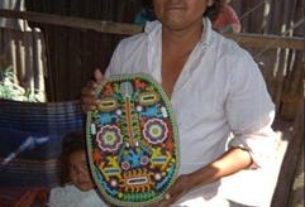I just returned from four days in Huatulco, located along the coast of Oaxaca at the end of the Southern Sierra Madre mountains. The area’s nine bays and twenty-three beaches stretch 35 kilometers along the Pacific Ocean’s seashore between the Coyula and Copalita rivers.
After the horrible death of my poodle Pierre, I needed to get away for some R&R. Magnicharter had just begun flying direct from Guadalajara to Huatulco. “Why not?” said my friend Linda Rose when I asked her if she wanted a short vacation. Her husband agreed to stay home and dog sit.
Although we’re in the midst of the rainy season, a quick check on the Internet showed no impending hurricanes and, except for the Wicked Witch of the West, water never hurt anyone. It rained only one night and the weather the rest of the time was beautiful.
The plane transported 94 passengers, only four of whom were not Mexicans. Linda and I stayed at the Castillo Huatulco, located in the bay of Santa Cruz. The other foreigners chose to stay at the Sheraton in the bay of Tongolunda, close to Club Med.
The Bahías (Bays) de Huatulco is a planned development with a couple of interesting twists. Three of the bays are completed. Phase II will be completed in the next three years and the final three bays will be developed in Phase III. No buildings may rise higher than six stories and all rooftops must be of red Mexican tile. The lush vegetation and forests in this tropical region remind me of various islands in Hawaii.
Middle-class Mexican families have discovered Huatulco. The workers and former residents of Santa Cruz and Tongalunda have been relocated to a beautiful village called La Crucecita, only 1.2 miles away. It’s built around a central square in front of an impressive church with domed 31-meter high ceilings. Our Lady of Guadalupe is painted in the center of the ceiling with the artist’s rendition of star-studded blue skies flanking her on either side.
A myriad of shops, restaurants and services welcome visitors who want to browse for local arts and crafts and enjoy fine meals.
We learned the history of Huatulco from a bilingual guide who met us with a transport bus at the airport. After unpacking, Linda Rose and I ventured to the beach, located beyond the new marina in front of our hotel. Several restaurants served drinks and food under round palapas. We ordered our “welcome” drinks — mine a piña colada and hers a margarita Huatulco — and enjoyed the beautiful view until the check came. They cost 50 pesos each. “American prices!” I gasped.
We wanted lobster for dinner, so we caught a cab for the short trip to La Crucecita and began comparing menus. One particularly tenacious restaurateur, Antonio, coaxed us into his place, called ‘Cactus’, with promises of one free drink each. He showed us the langosta, a longer, thinner version of Maine lobster. Three whole ones for 180 pesos. We decided after a short walking tour of the town to eat at Antonio’s after all.
Linda Rose and I shared a dish of jumbo shrimp flamed at the table in a sweet teriyaki sauce, a sautéed mushroom appetizer and a platter of langosta. What a feast! When we presented a discount coupon for 15% the travel agency had given us, Antonio added back the price of the “free” drinks. He said, “Only one discount — drinks or fifteen percent.” Oh well, it was worth trying.
The next day we headed out for a tour of the bays on a large catamaran named Tequila. What a trip. The boat is outfitted for 120 passengers and it was full. The 200 pesos included an open bar. Equipment rental for snorkeling was an additional 40 pesos. This would normally have been a great trip, but the wind and the waves made it more like a roller coaster ride than a boat ride. In addition to free drinks (which most of us refused), the waiters passed out vomit bags (which many accepted gratefully).
When we did stop in the bay of San Agustin for snorkeling, the water was calmer. Of course, nothing lives up to the vivid colors of underwater plant and animal life of the South Pacific, but we enjoyed some pleasurable moments communing with Mother Nature’s underworld. The trip took all day and included a lunch on the beach at Maguey where we swam a bit longer in the tepid Huatulco waters.
The next day we went into La Crucecita again, did some shopping and then headed out to the new Beach Club in Chahue Bay. It’s open to the public, but with our wristbands, we were given free bus transport to and from the club and a 15% discount for meals. The club is a lovely place. On the beach were several palapas and lounges for relaxing and enjoying the water. A red flag blew in the breeze which we later learned meant “dangerous undertow.” Fortunately, we’d decided to languidly lounge in the huge pool and take a nap in one of the many hammocks under a giant palapa.
The food, service and prices there were great. They have a volleyball court for the more ambitious and cement lounges that keep all of your body underwater with the exception of your head. It was a great place to sip Bloody Marys.
Huatulco is still unspoiled. It’s beaches are pristine. There are no high-rise hotels, no loud, ugly Tourists demanding they have it their way, and no screaming kids. The few beach vendors we saw weren’t pushy. If you said “no,” they smiled and moved on.
Activities abound for almost everyone: Horseback riding, jungle tours, white river rafting, snorkeling, jet skis and motorbike rentals as well as sailing, scuba diving and land tours to Puerto Escondido and Puerto Angel. You can even get your picture taken with an iguana.
The night life there is limited unless you choose one of the all-inclusive resorts, but for Linda Rose and I, there was just the right mix of quiet and excitement. Huatulco. I highly recommend it and hope it will never turn into a Puerto Vallarta, Cabo or Cancun.


